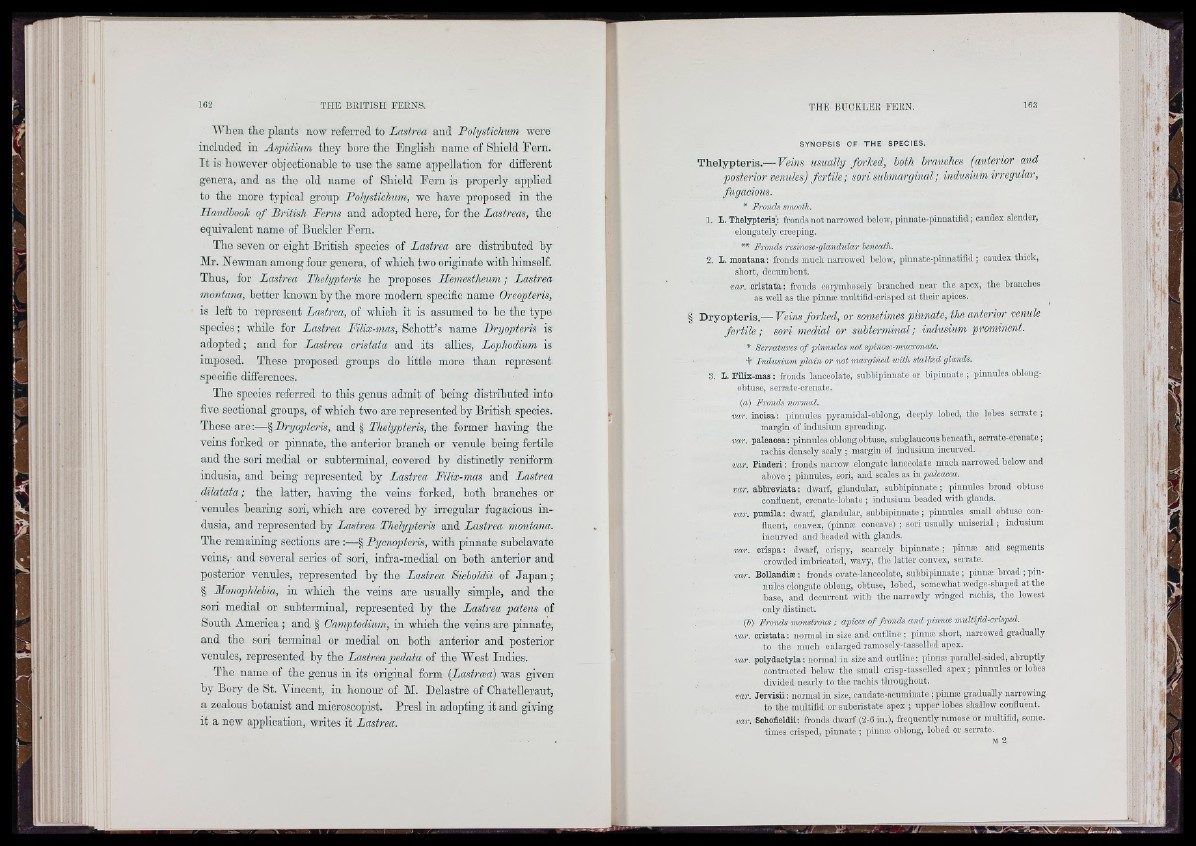
IVhcii the plants now rcforrod to Lastrea and Polystichum wore
included iu Aspidium they bore the English name of Shield Fern.
I t is however objectionable to uso the samo appellation for different
genera, and as tho old name of Shield Fern is properly applied
to the moro typical group Polystichum, we have proposed in the
Handbook o f British Perns and adopted here, for the Lástreos, the
equivalent name of Buclder Fern.
The seven or eight British species of Lastrea aro distributed by
Mr. Neivman among four genera, of which two originate with himself.
Thus, for Lastrea Thehjpteris he proposes Hemestheum; Lastrea
montana, better known by the more modern specific name Oreopteris,
is left to represent Lastrea, of which it is assumed to bo the type
species; whilo for Lastrea PiUx-mas, Schott’s name Dryopteris is
adopted; and for Lastrea cristata and its allies, Lophodium is
imposed. These proposed groups do little more than represent
specific differences.
The species referred to this genus admit of being distributed into
five sectional groups, of which two are represented by British species.
These a re :—§ Dryopteris, and § Thelypteris, the former having the
veins forked or pinnate, the anterior branch or venule being fertile
and the sori medial or subterminal, covered by distinctly reniform
indusia, and being represented by Lastrea Pilix-mas and Lastrea
dilatata; the latter, having the veins forked, both branches or
venules hearing sori, which are covered hy irregular fugacious indusia,
and represented by Lastrea Thelypteris and Lastrea montana.
The remaining sections a r e :—§ Pycnopteris, with pinnate snholavate
veins,- and several series of sori, infra-medial on both anterior and
posterior venules, represented by the Lastrea Sieboldii of Japan ;
§ Monophlebia, in which the veins are usually simple, and the
sori medial or subterminal, represented by the Lastrea patens of
South America ; and § Oamptodium, in which the veins are pinnate,
and the sori terminal or medial on both anterior and posterior
venules, represented hy the Lastrea pedata of the "West Indies.
The name of the genus in its original form {Lastraia) was given
by Bory de St. Vincent, in honour of M. Delastre of Chatelleraut,
a zealous botanist and microsoopist. Presl in adopting it and giving
it a new application, writes it Lastrea,
SYNOPSIS CF TH E SPECIES.
Thelypteris.— Veins xisually forked, both branches (anterior and
posterior venules) fertile; sori submarginal ; indusium irregular,
fugacious.
* Fronds smooth.
1. L. Thelypteris) fronds n o t narrowed below, pinnate-pinnatifid ; candex slender,
elongately creeping.
** Fronds resinose-gland^dar beneath.
2. L. montana: fronds much narrowed below, piunate-xnimatifid ; caudex thick,
short, decumbent.
var. crista ta : fronds corymbosely branched near th e apex, th e branches
as well as th e pinnæ multifid-crisped a t th e ir apices.
Dryopteris.— Veins forked, or sometimes pinnate, the anterior venule
fertile; sori medial or subterminal; indusium prominent.
* Serratures o f p in n u les not spinose-mucronate.
+ Indusiv/m p la in or not margined with stalked glands.
3. L. Filix-mas : fronds lanceolate, suhbipinnate or bipinnate ; pinnules oblongobtuse,
serrate-crenate.
(a) Fronds normal,
var. incisa : pinnules pyramidal-oblong, deeply lobed, th e lobes serrate ;
margin of indusium spreading.
var. paleacea : pinnules oblong obtuse, subglaucous beneath, serrate-crenate ;
rachis densely scaly ; margin of indusium incurved.
var. Pinderi : fronds iian’ow elongate lanceolate much narrowed below and
above ; pinnules, sori, and scales as in paleacea.
var. abbreviata : dwarf, glandular, subbipiiinate ; pinnules broad obtuse
confluent, crenate-lobate ; indusium beaded with glands.
var. pumila : dwarf, glandular, suhbipinnate ; pinnules small obtuse confluent,
convex, (pinnæ concave) ; sori usually uniserial ; indusium
incurved and beaded with glands.
var. crispa : dwarf, crispy, scarcely bijiinnate ; pinnæ and segments
crowded imbricated, wavy, th e la tte r convex, serrate.
var. Bollandiæ : fronds ovate-lanceolate, suhbipinnate ; pinnæ broad ; p in nules
elongate oblong, obtuse, lobed, somewhat wedge-shaped a t the
base, and decurrent with th e naiTowly winged rachis, th e lowest
only distinct.
(b) Fronds monstrous ; apices o f fronds and pinnæ multifid-crisped.
var. c ristata : normal in size and outline ; pinnæ short, narrowed gradually
to th e much enlarged ramosely-tasselled apex.
var. polydactyla: normal in size and outline; pinnæ parallel-sided, abruptly
contracted below th e small crisp-tasselled apex; pinnules or lobes
divided nearly to th e rachis throughout.
var. Jervisii: normal in size, caudate-acuminate ; pinnæ gradually narrowing
to th e multifid or subcristate apex ; upper lobes shallow confiuent.
var. Schofieldii: fronds dwmf (2 -6 in.), frequently ramose or multifid, sometimes
crisped, pinnate ; pinnæ oblong, lobed or serrate.
M 2